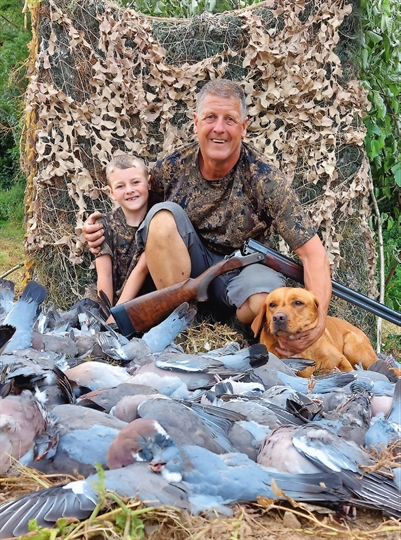Drenched and disappointed
Constant rain has plagued farmers right across the UK, while pesky pigeons have only added to the misery on Andy Crow’s farm by hammering his precious pea crop.

This summer has probably been a fairly miserable one for a lot of people – no tan, almost no BBQs, and a depressing amount of biblical rain – but for a farmer like Andy, it has been disastrous. The endless rain has interfered severely with the harvest, which means when the sun does shine, Crowman has to make the most of the opportunity to get things done, often working 20-hour days, several days on the trot. We manage to snatch a rare break in his schedule for an afternoon visit – and if it weren’t for the pigeons ravaging the pea crop to such an extent that Andy can’t leave them any longer, we wouldn’t be here at all.
Getting Started
The day doesn’t get off to a good start – we get stuck in traffic on the M25 and Andy’s sprayer malfunctions, meaning a trip back to the farm for a repair and refill. This is followed by another hour of spraying while we wait in the farmyard, twiddling our thumbs and secretly pleased it’s not us causing the delay for once.
Keeping Spirits High
Understandably, Crow is not in the best of moods when we finally load up the Polaris with our kit, an hour and a half later than planned. At least young Regan, Andy’s grandson, is here to keep spirits high, and it turns out it’s not all doom and gloom for the day ahead.
“Luckily, it doesn’t matter that we’re here a bit later than expected,” says Andy. “With peas, it doesn’t take the birds long to fill their crops, so they do tend to feed a bit later in the afternoon than they would usually.”
We arrive at the top of a field of peas in time to see a huge flock of pigeons lifting up off the ground at the far end. Parking up, we unload all the gear and trudge down to the far corner where the field joins some woodland. Andy knows the flight paths and is expecting some birds to come from the top of the hill, while others make their way through a gap in the line of trees dividing the crop from the woodland.
Setting Up
He sets up the hide slightly away from the second line of trees that make up the corner of the field, about 20 yards into the crops. This plan serves three purposes: it puts him closer to the flight path of the birds coming from the woodland, allows 360° shooting angles, and also means he will be able to shoot anything flying along the top of the tree canopy ‘behind’ him, which he wouldn’t be able to see if he set the hide snug up against those trees.
For the hide itself, he constructs a small, four-sided, wonky circle with the poles before draping it in several layers of camouflage netting. Finally, to disguise it even more and further hide him from view, he cuts long branches and tucks them into the netting, focusing on the woodland side of the hide where the birds are likely to be flying a little higher. The final result looks as if a little bushy tree has sprung up at the edge of the crop. He’s using real birds as decoys and sets them out in the peas in a semicircle in front of the hide. There’s no flapper today, but he adds a rotary onto the left side to encourage the birds down the hill.
With everything in place and time ticking on, Andy, Regan, and Rosa bundle into one hide, while Adam (our cameraman) and I tuck ourselves back into a mini hide at the woodland edge to try to capture the action.
The Birds Begin to Move
Mercifully, Andy’s day swiftly gets better as the birds begin to move. His predictions are spot on, if a little conservative. The birds are taking pretty much the paths he thought they would, but they’re very high, and they don’t seem to be overly interested in the decoys. Not ideal, perhaps, but we do get to witness a phenomenal display of shooting as he plucks them precisely out of the air at ranges I wouldn’t even attempt.
They keep coming steadily as the day continues, with plenty coming from the woodland behind and being shot over the top of the trees. A few hours go by with most of the birds still being taken at a fair distance, and as the wind changes direction, Andy decides to move the rotary to the other side of the hide to see if it will help draw them in a little closer. It works quite nicely, and although they can hardly be described as close, he gets some fantastic shots off as the birds come hurtling up the field along the treeline and swoop across in front of the hide, presenting that beautiful underside shot as they flare away.
Final Tally
By the time the action dies down and we decide to call it a day, we’re all a lot happier than we were at the start of it. There’s been some great sport, some impressive shooting, and the final bag is around 70 birds. Adding cousin Gary’s birds in – who has been shooting another field on the same farm, helping to keep things moving – it’s a decent 140-bird day and some much-needed relief for the peas, which are due to be harvested in about 10 days.
“It was a tough start,” says Andy, “but it’s been a good day. It’s a lot more than I thought we were going to get.”





